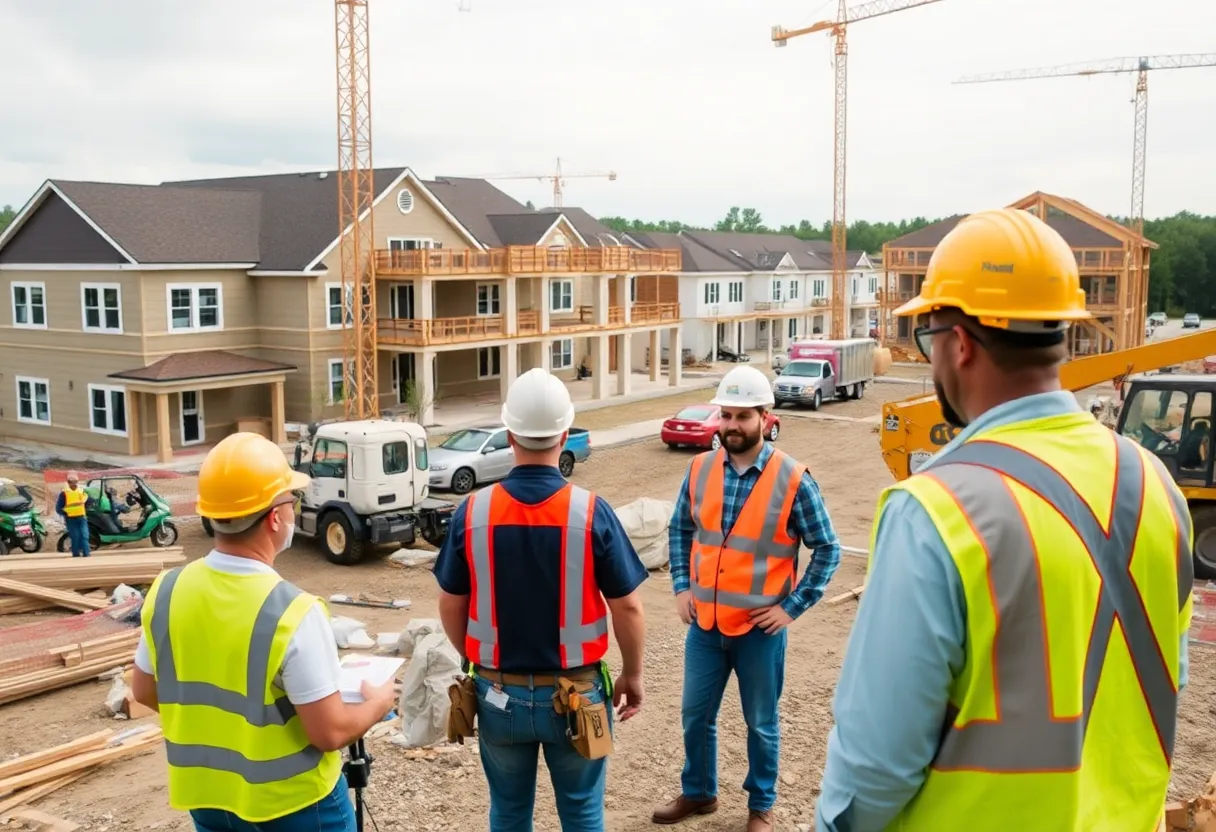North Carolina, August 1, 2025
News Summary
North Carolina’s construction industry is excelling despite a predicted national slowdown. Growth is driven by residential construction and effective market expansion strategies. Experts suggest that while some sectors like multifamily construction face challenges, data centers and specific other sectors are projected to thrive, creating new opportunities for construction firms. The state’s robust employment rates and wage growth highlight its strong construction environment, positioning it well for future developments.
North Carolina’s Construction Industry Thrives Amid Competitive Market Conditions
Durham, North Carolina – Despite a forecasted slowdown in national construction spending, North Carolina’s construction industry continues to thrive, driven by significant growth in residential construction and strategic expansions into new markets. As economic conditions evolve, construction professionals are adapting and strategizing to navigate challenges and seize new opportunities.
Economic forecasts predict a flattening or contraction in construction spending nationwide, influenced by rising material costs and increasing labor expenses that may impact the value of construction investments. However, experts note that residential construction spending in North Carolina is expected to see considerable growth in the coming years, outpacing national trends.
McKinney, a principal in FMI’s strategy practice, highlights the importance of differentiating services and effectively entering new geographic markets. In contrast, multifamily construction has recently experienced a slight decline due to pressures from rising interest rates. Commercial, industrial, civil, and institutional construction segments are projected for flat or modest growth over the next five years, reflecting mixed prospects.
Sector Insights and Growth Predictions
Data centers are a standout sector, projected to grow by 5% annually over the next five years. North Carolina has seen a remarkable 15-fold increase in data center constructions compared to a decade ago. Additionally, spending from the lodging, power, transportation, and education sectors is anticipated to rise, presenting further opportunities for construction firms.
However, certain sectors are expected to experience declines, particularly religious, public safety, and manufacturing. The top five metropolitan areas in North Carolina expected to see growth include Raleigh/Durham/Chapel Hill, Charlotte, Greensboro, Wilmington, and New Bern. Conversely, Winston-Salem, Hickory/Lenoir/Morganton, Burlington, and Fayetteville are facing slower growth projections.
Strategic Approaches for Construction Professionals
To capitalize on the growing markets, construction companies must adopt effective strategies. McKinney outlines three core approaches for diversification: adding new services, expanding into new industry sectors, and pursuing geographic diversification. The latter is recognized as one of the most challenging and common goals for businesses looking to thrive.
Furthermore, business owners are advised to assess their motivations and understand the demand in potential new locations before expanding. This involves researching market competition and operational costs to ensure a successful transition into new markets. While acquisitions can also drive growth, it is crucial for leaders to verify that any prospective purchase adds value and align with their long-term goals.
Evaluating staffing needs and feasibility of expansion, along with effective brand positioning in new areas, are additional considerations that construction professionals must keep in mind as they navigate current market conditions.
North Carolina’s Construction Landscape
North Carolina ranks as the fifth strongest construction industry in the United States, boosted by robust employment rates and wage growth within the sector. Between 2021 and 2024, construction wages in the state increased by 11.4%, while employment rose by 13%. Additionally, North Carolina recorded 19.11 new permits per 1,000 units during this period, further highlighting the industry’s active growth environment.
Idaho leads the nation in overall construction strength, followed by Arizona, Texas, and Utah. Conversely, Pennsylvania has the weakest construction industry, according to analysis from the U.S. Bureau of Labor Statistics and Census Bureau data.
Conclusion
As North Carolina’s construction industry continues to thrive, stakeholders must remain vigilant and innovative in their strategies to adapt to shifting market dynamics. With an eye toward specific sectors poised for growth, construction professionals can position themselves favorably as the industry evolves in the years ahead.
FAQ
What is the current state of North Carolina’s construction industry?
North Carolina’s construction industry is currently thriving, particularly in residential construction, despite forecasted declines in national spending. The industry is bolstered by projected growth in data centers and other sectors.
Which sectors are expected to grow or decline in the coming years?
Sectors such as lodging, power, transportation, and education are expected to see growth, while religious, public safety, and manufacturing sectors may experience declines.
What strategies should construction professionals consider for growth?
Construction professionals should consider strategies such as adding new services, expanding into new sectors, and pursuing geographic diversification to tap into growing markets effectively.
Key Features of North Carolina’s Construction Industry
| Feature | Current Status | Projection |
|---|---|---|
| Residential Construction Spending | Increasing | Significant growth expected |
| Multifamily Construction | Decreasing | Pressure from interest rates |
| Commercial and Industrial Sectors | Flat to Modest Growth | Consistent over next five years |
| Data Center Construction | Growing | Projecting 5% annual growth |
| Construction Wages Growth | 11.4% from 2021 to 2024 | Stable growth |
| Top Growing Metropolitan Areas | Raleigh/Durham/Chapel Hill, Charlotte, Greensboro, Wilmington, New Bern | Expected growth in these areas |
| Weakest Metropolitan Areas | Winston-Salem, Hickory/Lenoir/Morganton, Burlington, Fayetteville | Slower growth projections |
Deeper Dive: News & Info About This Topic
HERE Resources
TSMC Expands Semiconductor Operations in Phoenix
Thomas Maynard Appointed Interim CEO of Greater Phoenix Economic Council
Shifts in the Phoenix Housing Market Favor Buyers
Federal Reserve Maintains Interest Rates Amid Inflation Concerns
Jersey City Secures $255 Million in Real Estate Refinancing
Compass Achieves Record Financial Results in Second Quarter
Baltimore Developer Files for Bankruptcy Amid Financial Struggles
5 Must-Ask Questions for Understanding Phoenix’s Real Estate Market
Data Center Development Poised to Transform Beaver Dam
Metro Phoenix Housing Market Faces Affordability Crisis
Additional Resources
- CBS 17: North Carolina has 5th strongest construction industry
- Wikipedia: Construction industry
- Business North Carolina: Protecting your construction budget in 2025
- Google Search: North Carolina construction growth
- News & Observer: Real estate news in North Carolina
- Encyclopedia Britannica: Construction
- National Law Review: Antitrust compliance for construction companies
- Google News: North Carolina construction industry
- Ward and Smith: Highlights of North Carolina construction legends
Author: STAFF HERE PHOENIX WRITER
The PHOENIX STAFF WRITER represents the experienced team at HEREPhoenix.com, your go-to source for actionable local news and information in Phoenix, Maricopa County, and beyond. Specializing in "news you can use," we cover essential topics like product reviews for personal and business needs, local business directories, politics, real estate trends, neighborhood insights, and state news affecting the area—with deep expertise drawn from years of dedicated reporting and strong community input, including local press releases and business updates. We deliver top reporting on high-value events such as the Waste Management Phoenix Open, Cactus League Spring Training, and Arizona State Fair. Our coverage extends to key organizations like the Greater Phoenix Chamber of Commerce and Visit Phoenix, plus leading businesses in technology and healthcare that power the local economy such as Intel and Banner Health. As part of the broader HERE network, including HERETucson.com, we provide comprehensive, credible insights into Arizona's dynamic landscape.





